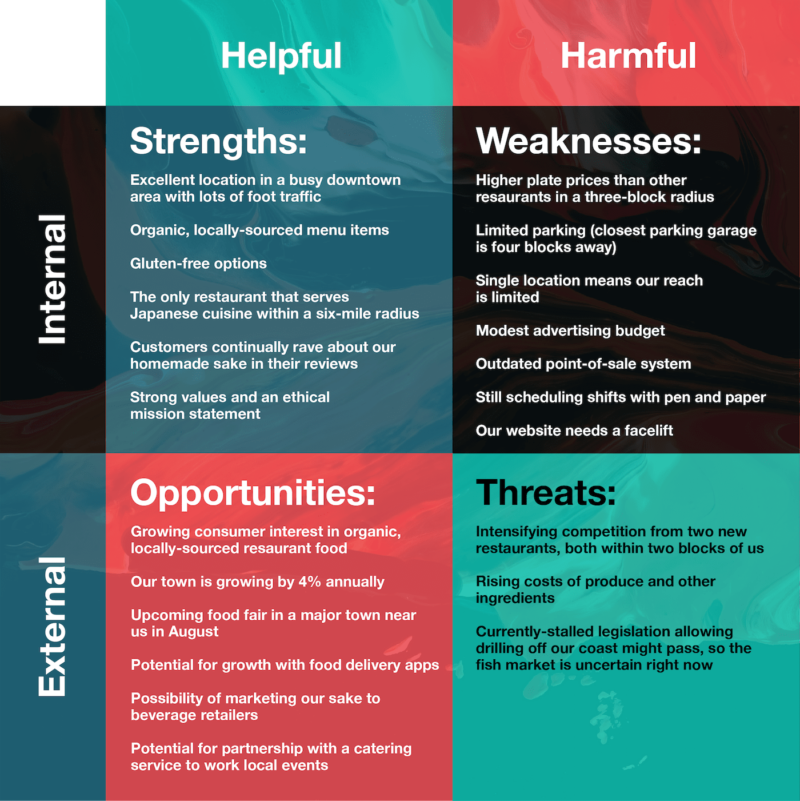Now that you’ve already done the intensive work of conducting a SWO T analysis with your team—assessing your Strengths, Weaknesses, Opportunities, and Threats—you’ve probably got a lot of material to work with. Your SWOT analysis should give you a clear, comprehensive sense of your business’s internal strengths and weaknesses, as well as the external factors that represent possible opportunities and threats to your organization. Now what do you do with all this information? How does your SWOT analysis is inform the next market research campaign you take on?
Analyzing Your SWOT Results
As you fleshed out the four categories in your SWOT matrix, you probably began to recognize relationships between the items in its quadrants. Here are some questions worth asking yourself (and your team) to clarify the ways these four categories inform each other:
- How can we act on our company’s strengths to maximize the business opportunities we identified?
- How can we use the strengths we identified to combat or reduce the threats we described?
- How can we overcome or minimize the weaknesses we identified so we can better use the opportunities we found?
- How can we overcome or minimize the weaknesses we identified to avoid the threats we listed?
- Will taking advantage of the opportunities we listed ultimately neutralize any of our threats?
- Can any of our strengths correct any of our weaknesses?
Your initial answers to these questions don’t have to be complex, or even fully fleshed out (leave that to your market research). For now, you only need to recognize what you can utilize and draw on, and what needs to be minimized or avoided, in order for your business to be even more successful.
Once you’ve answered these questions, you’re in a position to prioritize which of these matters to tackle first in your market research. What you decide to prioritize will likely be based on some combination of:
1) the likelihood of it happening: you’re focusing on capitalizing on an opportunity or minimizing a threat
2) the feasibility of implementation: you’re focusing on utilizing a strength
3) a possible increase in profits: you discovered a viable solution
Translating a SWOT Analysis into Market Research Questions
For example, let’s look at a fictitious Japanese restaurant located in a seaside tourist town which used its SWOT analysis to inform its market research strategies. Naturally, your SWOT matrix will look different from the one below, but hopefully it will serve as a model for what it can look like when the results of a situation analysis are narrowed down, prioritized, and translated into a set of actionable questions you can use to research more.
SWOT Example

Note we didn’t include specific numbers here (e.g., the amount allocated for their advertising budget or the price differentiation from the competition) because we didn’t need them for this example. As you conduct your own SWOT analysis, you’ll want to include those details.
Now, let’s imagine how a strategic planning conversation around the restaurant’s SWOT analysis chart might unfold. First, the participants might realize there are some items on the matrix that can be improved with easy fixes. For example, perhaps someone is put in charge of researching and acquiring a straightforward and economical employee scheduling software platform, which takes care of the fact one of their listed weaknesses (the restaurant is “still scheduling shifts with pen and paper”).
Looking at the restaurant with a big-picture perspective, though, we see that it’s got a strong reputation (especially among tourists who pass through and give them rave reviews after), an outstanding product in their sake, and a fairly strong location thanks to out-of-town foot traffic. However, much of their business comes from tourists and there’s a concern about what that might mean with new competition opening up and a less-than-ideal parking situation.
On the other hand, the fact that the town is growing means the local population in town is increasing. Maybe some SWOT participants realize that, in catering to tourists, the restaurant hasn’t addressed the local population as well as they could. Maybe that means they should register to participate in the food fair listed under Opportunities. It would mean, after all, tapping into the local population the next town over. If they do well at the fair, those residents might be willing to make the 25-minute drive on a weekend to visit their new favorite Japanese restaurant.
But it also suggests that the restaurant needs to find other ways to strengthen and nurture its relationships with local residents—a population that perhaps cooks dinner at home to avoid evening tourism on Main Street. Perhaps they ask “how could we get local residents to try our food for the first time?” As you can see, their advertising budget isn’t great, so that avenue is closed. Looking over their SWOT, one participant points to that last item in Opportunities: “Potential for partnership with a catering service to work local events.”
Now the restaurant suddenly has a direction for its market research campaign. A whole set of questions suddenly arises: How financially viable (let alone profitable) could such an endeavor be? Is there even a market for Japanese event catering in this area? And what do they mean when they say “this area”? A 15-mile radius? 30? How many catered events even occur in “this area”? And on it goes.
Our restaurant would then have to create a strategy for answering these questions. They might begin by reading industry reports on the state of the catering business (yes, they’re out there). They’d learn about industry growth, forecasts, and average profitability. They could narrow their search to data such as payroll and profitability by state. They might then seek out catering companies within a 50-mile radius of their restaurant, learn about their prices, their profitability, what their marketing looks like, how busy their social media profiles are, whom they’ve catered for. Maybe they’d look through local newspaper archives and marriage records, or contact cultural organizations such as museums, opera houses, and places of worship to find out how many events (weddings, holiday celebrations, graduation parties, and so on) are held annually in their town.
If initial research suggests that a catering company might indeed be a successful endeavor, it’s then time for primary research. This might come in the form of a simple questionnaire handed out to customers, a more formal, in-depth survey sent out to local organizations who often host events, or even a focus group composed of local event planners who could advise the restaurant on what they look for when hiring a catering company.
As the restaurant moves forward in its research, the questions would get more detailed: what dishes would prospects want, what dietary restrictions should they prepare for, what would customers be willing to pay for additional services, and so on.
Post-SWOT Analysis Steps
Hopefully, this fictional SWOT example gives you an idea of what’s possible in creating your own action plan. Your own SWOT analysis will allow you to take the following four steps to ready yourself for research:
1. Define the problem you want your market research to solve. There’s a lot of information out there, and diving into the data without a clear objective is only going to overwhelm you. Knowing what you need to know and why you need to know it will keep your research on target. Our restaurant, for example, used one primary question to lead their market research: how profitable would it be to introduce a catering aspect to our already-thriving restaurant?
2. Form a hypothesis about what your market research will reveal. You may end up being way off, but that’s not the point. Forming a hypothesis will keep you actively engaged in the process. What will you do if your predictions are proven right? What consequences will it have for your business? What if you’re proven wrong? Do you have a back-up plan in case you’re taken by surprise?
3. Translate your question from a business problem into a research objective. Once you know what you want your research to accomplish, you’ll have to figure out how to obtain the data to accomplish it. Will you have to dig into public data like financial records and annual reports? Will you gather your own data from surveys, focus groups, and one-on-one interviews? What sources will best answer the question you have? What will your methodology be? How long will it take? What are the costs?
4. Determine your sample size. How many people will you need to hear from to have an accurate picture of what your target market wants? How many prospects would have to express an interest in a new feature or service to make further research worthwhile? Your sample size will depend upon many things, but it’s good to have this criteria set before the research begins. After all, you’ll need to know when it’s time to stop, so you can move forward with implementation.
Congratulations! You’ve got your market research question in hand. In the next section, we’ll dive into the details of competitor research—the strategies for gathering as much valuable information about your competitors as possible.
